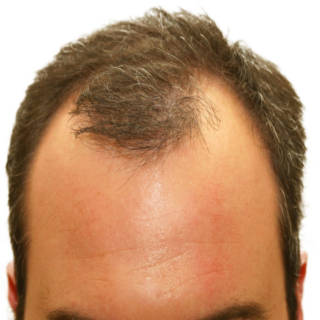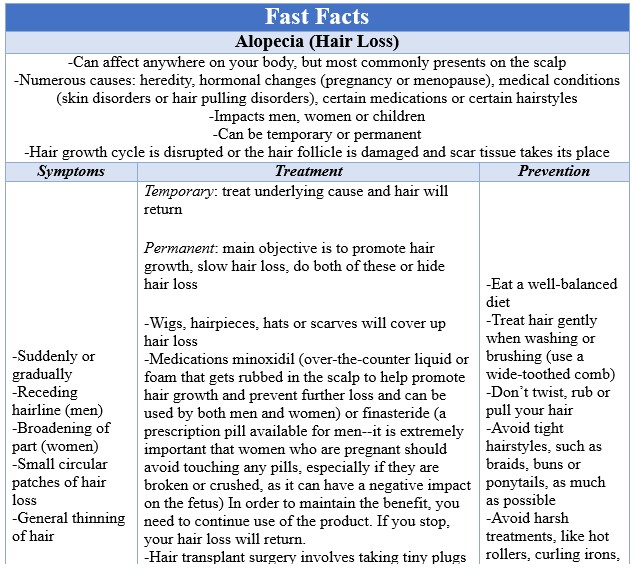Is it normal?
One day you’re in the bathroom getting ready to go to work and notice that your hair is starting to thin in some spots. For some people, the loss of hair can be quite upsetting. What does this mean? Is it permanent or temporary? Can anything be done to stop or fix it?
 Definition
Definition
Alopecia, or hair loss, can affect anywhere on your body, but most commonly presents on the scalp. There are numerous causes, such as heredity, hormonal changes (pregnancy or menopause), medical conditions (skin disorders or hair pulling disorders), certain medications or certain hairstyles. It can impact men, women or children. Depending on the cause, the symptoms can appear suddenly or gradually and can be temporary or permanent. While it is normal for people to lose about 50-100 hairs a day, it isn’t noticeable because new hair is constantly growing. Noticeable hair loss is when the hair growth cycle is disrupted or the hair follicle is damaged and scar tissue takes its place.
Baldness, most common type, is a gradual, permanent thinning of hair on the top of the head as you age caused by heredity. As this progresses, men typically have a receding hairline from their forehead, whereas, women have broadening of the part in their hair. Some people have circular or patchy bald spots on their scalp (it can occur in beards or eyebrows too). In some of these cases, people have itching or pain in the area before the hair falls out. One form of this is Alopecia areata, which is when your body’s immune system attacks the hair follicles. Another type of hair loss is from physical or emotional stress or shock. In these scenarios, hair comes out in handfuls while it is being combed, washed or gently tugged. This results in an overall thinning but no bare patches. It is usually temporary and hair will grow back once the stress is gone. Full body hair loss is usually due to a medical condition or medication, such as chemotherapy. The hair loss is usually temporary. Scalp infections, like ringworm, can cause temporary hair loss that grows back once the infection is treated. Traction alopecia is when people, usually women, lose hair from frequently having their hair pulled back into a ponytail or similar style that is too tight.
Treatment
Most temporary hair loss doesn’t require treatment to replace the hair as it will grow back on its own. The most important thing to treat is the underlying cause by addressing any medical conditions or any other reason that is attributing to the hair loss. For permanent hair loss, the main objective is to promote hair growth, slow hair loss, do both of these or hide hair loss. Wigs, hairpieces, hats or scarves are all excellent options if you are covering up your hair loss. Some people try medications like minoxidil which comes in an over-the-counter liquid or foam that gets rubbed in the scalp to help promote hair growth and prevent further loss. This can be used by both men and women. In order to maintain the benefit, you need to continue use of the product. If you stop using it, your hair loss will return. A prescription pill, finasteride, that is available for men also needs to be continually taken in order to maintain the hair growth and loss prevention. It is extremely important to note that women who are pregnant should avoid touching any pills, especially if they are broken or crushed, as it can have a negative impact on the fetus. Some individuals opt for a hair transplant surgery. This involves taking tiny plugs of skin, they have a few hairs in each of them, from your back or the sides of your scalp and implanting them in the bald section. This process is painful and expensive, so it is usually reserved for the most common permanent hair loss type in which only the top of the head is affected. In some cases, you still need to take hair loss medication to help improve the results.
Prevention
While you cannot change your genes, there are some things that you can do to help lessen the chances of having hair loss. It is important to eat a well-balanced diet since poor nutrition has been linked to hair loss. Treat your hair gently when washing or brushing it. It is a good idea to use a wide-toothed comb. Don’t twist, rub or pull your hair as this can cause damage to the follicles and loosen your hair. Try to avoid tight hairstyles, such as braids, buns or ponytails, as much as possible. Also, avoiding harsh treatments, like hot rollers, curling irons, flat irons, hot oil treatments or perms, on a regularly basis can be helpful.
Hair loss can come as a shock and be very upsetting. There are things that you can do to help prevent and manage it. If you have any questions or concerns about hair loss, please speak with your doctor. If you would like more information, please visit the American Academy of Dermatology’s hair loss page at https://www.aad.org/public/diseases/hair-and-scalp-problems/hair-loss